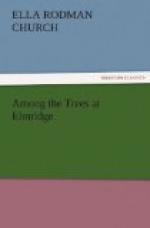“But the nuts are good,” said Malcolm. “Didn’t we have fine times picking ’em up?”
“We did indeed,” replied Miss Harson, “and I hope we shall again.”
“How long will it be before they are ripe?” asked the little girls.
“Just about five months, I think.”
“Oh dear!” was the reply; “that’s so long to wait!”
“But you needn’t wait,” said their governess; “you can enjoy each season as it comes, and all the good things that our heavenly Father sends with it. Remember that, as you cannot expect ripe nuts in May or June, neither can you look for strawberries and roses in October. Tents are of very little use then, too.”
“Oh!” exclaimed the children, to whom the tent was still a delightful novelty; and they decided not to wish just yet for nutting-time to come.
“The nut, as you have so often seen, is covered with a brown husk that is very thick and marked with four furrows, by which it separates into as many distinct pieces, one being larger than the rest. The nuts differ very much in size and shape, and also in hardness, but the best kinds have thin shells and soft kernels; they are also rounder and fuller than the poorer sorts. There is a peculiar sweetness in the taste of this nut when in its best condition, and it is quite equal to the European walnut. The wood of this tree is particularly valuable for fuel, and in old times, when wood-fires were the only kind known, a good hickory back-log was sure to be found on every hearth. It is the heaviest of our native woods, and the wise men say that it yields, pound for pound or cord for cord, more heat than any other, in any shape in which it may be consumed.”
“But what a pity,” said Clara, “to burn up trees that bear nuts! Why can’t they take those that don’t?”
“They are not so desirable for fuel,” was the reply; “and when people own trees which they are willing to turn into money, they generally consider in what way they can get the most for them. Nuts which grow in the woods and fields are a very uncertain crop, of which every one seems to gather more than the owner, and it is therefore more profitable for him to cut his trees down and sell them for their wood, which the people in the cities and towns are so glad to get.”
“What’s the use,” asked Malcolm, “of calling a tree such a name as mocker-nut? What does it mean?”
“That is just what I have not been able to find out,” replied Miss Harson, “but it has an Indian sound, and it seems that the Indians used to make a black dye from the bark; so we will give them the credit for it. The name is not often used, for the tree is generally known as the white walnut. The nut is the largest of the hickories, being often from four to six inches around, and it is shaped somewhat like a pear. One variety, however, is known as the square nut. The shell is very thick and hard, but the kernel is sweet when once it is gotten out. This tree is as stately




